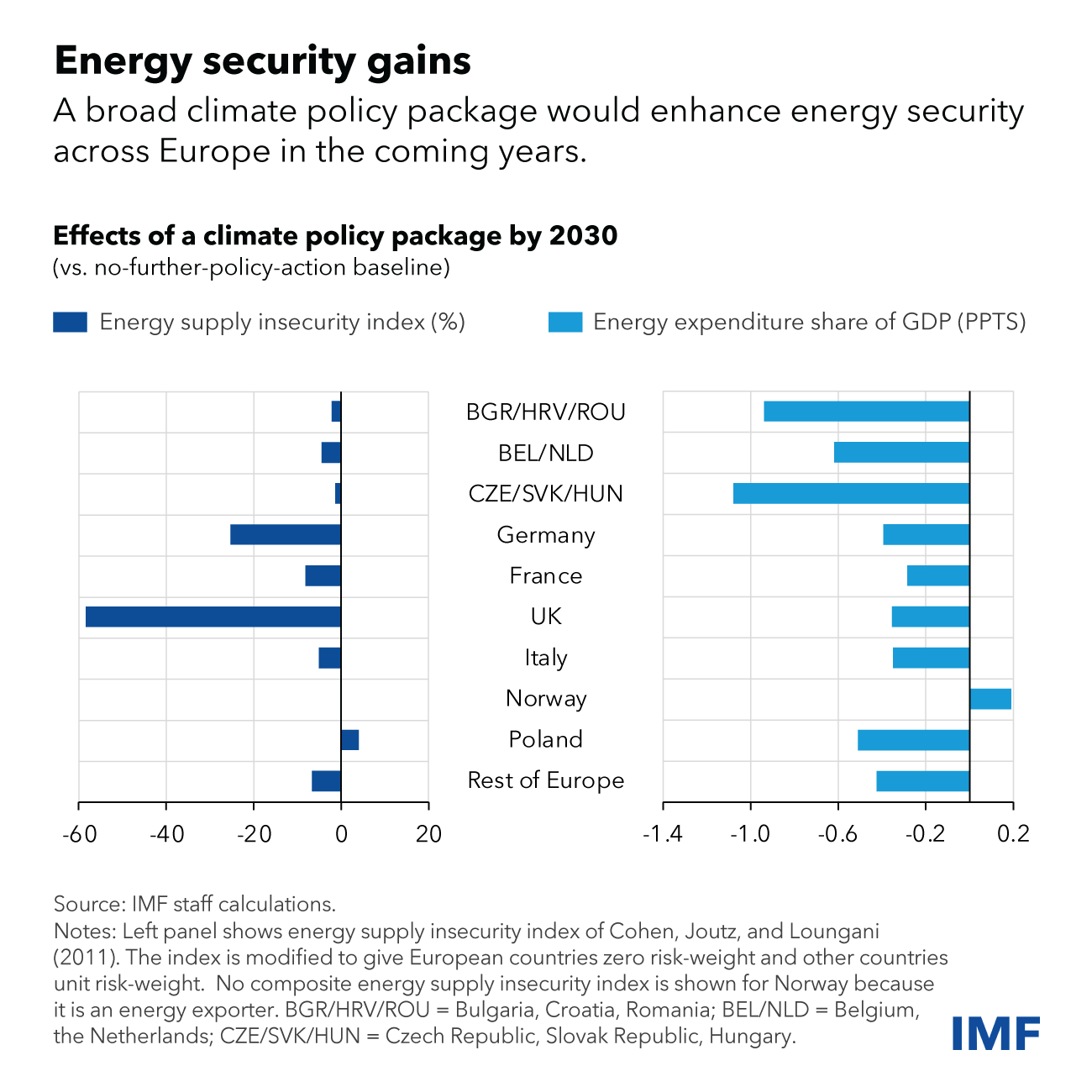Russia’s invasion of Ukraine triggered Europe’s worst energy crisis since the 1970s and put energy security back at the top of the policy agenda.
Policymakers reacted swiftly by securing alternative natural gas supplies, improving energy efficiency, and expanding renewables. Reducing greenhouse gas emissions would, they said, not only mitigate climate change but also strengthen energy security. Skeptics, however, countered that this approach would increase the cost of energy, phase out safe (albeit dirty) domestic coal more rapidly, and ultimately weaken the continent’s energy security.
So, which view is correct? Our new research shows that boosting Europe’s climate action delivers sizable energy security benefits, too.
We weigh the effects of climate action on energy security in a global economic model with many countries and sectors. It simulates the impacts of policies to reduce emissions on two essential security measures.
The first measure, security of supply, assesses the risk of a disruption to energy supply by combining how dependent a country is on imports for its energy consumption with how diversified those energy imports are. The second is the resilience of its economy to an energy disruption, represented by the share of gross domestic product it spends on energy.
Strikingly, our analysis reveals that Europe’s energy security deteriorated in the decades before Russia’s invasion of Ukraine, as countries relied increasingly on imports from ever fewer suppliers.
The simulations also show that higher carbon prices, stronger sector-specific energy efficiency regulations, and accelerated permitting for renewables would all improve Europe’s energy security along these two key metrics. Effects would differ across policies, however:
- Carbon pricing cuts emissions at the lowest output cost to the economy but may take time to improve energy security in some energy- and emission-intensive economies in Central and Eastern Europe, if used as the only emission-reduction tool. This is partly because these countries would have to phase out domestic coal sooner than otherwise.
- Stronger energy-efficiency regulations for transport and buildings, by contrast, are less efficient than carbon pricing in cutting emissions, but they deliver larger energy security co-benefits. They also spread those benefits more evenly across countries. Such regulations lower the consumption of energy, just as carbon pricing does, but they tend to reduce the price of energy—and thereby overall energy expenditures—more. Combining them with support to poorer households—for purchases of more energy-efficient vehicles and domestic heating systems, for example—would make them more palatable and thereby speed up implementation.
- Accelerated permitting for renewables also improves energy security widely across Europe by expanding domestic energy supply.
Packaging climate policies
A climate policy package that includes all these tools is the most promising way forward because it combines the economic efficiency of carbon pricing with the larger and more evenly shared energy security benefits of regulations.
Specifically, a package of measures improves energy security in three ways. First, it lowers dependence on imports by replacing imported fossil fuels with domestically produced renewable electricity.
Second, it diversifies individual economies’ energy imports away from non-European suppliers toward European ones—through enhanced penetration of renewables and electrification of end uses such as vehicles and house heating systems, in particular, given that European countries predominantly trade electricity with their European neighbors.
And third, it lowers energy expenditures because efficiency investments reduce demand and accelerated renewables deployment raises energy supply—both of which lead to lower energy prices. This more than offsets the higher cost from higher carbon pricing.
An illustrative policy package that cuts emissions by 55 percent compared to 1990 levels would improve the two energy security metrics by close to 8 percent by 2030 for Europe as a whole.
For the European Union, this package, which is consistent with the “Fit-for-55” agenda, would reverse 13 years of deterioration in economic resilience to energy disruptions and eight years of reduction in security of energy supply. As Europe continues to ramp up its climate policy action beyond 2030, these gains would only increase.
Multilateral cooperation
The simulations also support the case for strong multilateral cooperation within Europe, given that countries differ in their energy security gains and emission reduction costs (which, in turn, reflect factors such as their current energy intensity, energy mix, and potential for renewable power generation). A common facility that would pool resources and coordinate green investments at the EU level could accelerate the green transition at low cost while distributing its gains more evenly, including by tapping cheap abatement options in emerging EU member countries.
Completing the EU’s energy union strategy is a case in point: better connecting national grids would lower costs and help individual countries import electricity from other member countries in the event of domestic disruptions, improving energy security for all.
At a time when the momentum behind climate action is at risk of fading, European policymakers should consider its full benefits. By ramping up their individual emission reduction policies as planned and strengthening their cooperation, not only will they remain global leaders on the path toward net zero emissions by 2050, but they will also secure abundant and safe energy supply to power their economies into the future.
—Subscribe to our blogs and other IMF publications via this link.





